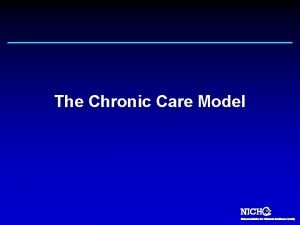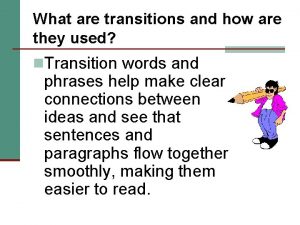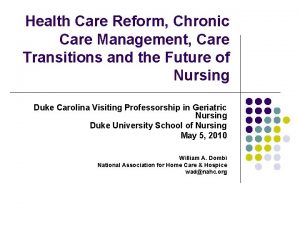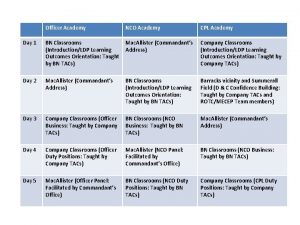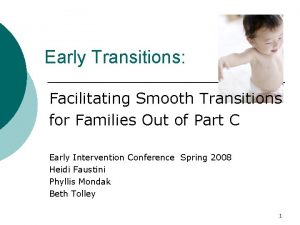Transitions of Care Presentation Developed for the Academy






















- Slides: 22

Transitions of Care Presentation Developed for the Academy of Managed Care Pharmacy Updated: February 2015

Definition Transition of Care – Movement of patients from one health care practitioner or setting to another as their condition and care needs change – Occurs at multiple levels • Between settings: Hospital ↔ Sub-acute facility, Hospital ↔ Home • Within settings: ICU ↔ Ward – Across Health States • Curative care ↔ Palliative care/Hospice

Statistics • 1 in 5 patients discharged from hospital to home experience an adverse event within three weeks • 1 in 5 Medicare patients readmitted within 30 days after discharge National Transitions of Care Coalition. Accessed at: http: //www. ntocc. org/Portals/0/PDF/Resources/NTOCCIssue. Briefs. pdf

Transitions of Care Issues An older man with atrial fibrillation who takes warfarin for stroke prophylaxis was hospitalized for pneumonia. His dose of warfarin was adjusted during the hospital stay and was not reduced to his usual dose prior to discharge. The new dose turned out to be double his usual dose, and within two days he was rehospitalized with uncontrolled bleeding.

Transitions of Care Issues EXCERPT FROM AN INTERNAL MEMO TO PHYSICIAN STAFF: “ It was recently noted that medication reconciliation was an issue on one of our patients. Since the patient was critically ill and no family was present, the home medication list was not obtained by the RN at time of presentation. While the physician prepared the discharge reconciliation, it was not identified that the home medication list was never obtained and the patient was confused after discharge about what medications to take…. ”

Reasons for Poor Transitions • Low level of patient activation • Lack of standardized and generally known processes • Inadequate transfer of information across settings

Ineffective Transitions = Poor Outcomes • Wrong treatment • Delay in diagnosis • Severe adverse events • Increased healthcare costs • Increased length of stay Australian Council for Safety and Quality in Health Care. Clinical hand-over and Patient Safety literature Review Report. March 2005. Available at: www. safetyandquality. org/internet/safety/publishing. nsf/Content/AA 1369 AD 4 AC 5 FC 2 ACA 2571 BF 0081 CD 95/$File/clinhovrl itrev. pdf

Poor Transitions of Care Lead to… • Medication errors • Increased health care utilization • Inefficient/duplicative care • Inadequate patient/caregiver preparation • Inadequate follow-up care • Member dissatisfaction

What is Transitional Care? • A set of actions designed to ensure the coordination and continuity of health care as patients transfer between different locations or different levels of care • Based on a comprehensive care plan and availability of well-trained practitioners that have current information about the patient’s goals, preferences and clinical status • Includes: – Logistical arrangements – Education of the patient and family caregiver – Coordination among the health professionals involved in the transition Coleman EA, Boult C, The American Geriatrics Society Health Care Systems Committee. J Am Geriatr Soc 2003; 51: 556 -7.

Essential Interventions 1. Medication management 2. Transition planning 3. Patient and family engagement/education 4. Information transfer 5. Follow-up care 6. Healthcare provider engagement 7. Shared accountability across providers and organizations

Partnership for Patients • New nationwide public-private partnership to tackle all forms of harm to patients • Focus: Better care, lower costs • Healthcare providers, health plans, employers, patient advocates, state and federal governments • Improve quality, safety, and affordability of health care for all Americans

Partnership for Patients - Goals Keep patients from getting injured, sicker: 40% reduction in preventable hospital acquired conditions by end of 2014 • 1. 8 million fewer injuries • 60, 000 lives saved Help patients heal without complications: 20% reduction in 30 -day readmissions by end of 2014 • 1. 6 million patients recover without readmission Potential to Save $35 billion in three years, including $10 billion for Medicare

Partnership for Patients – Interim Results • Evaluation found clear evidence for decreased rates of harms in five of the eleven areas: – Obstetrical early elective deliveries (OB-EED) – Readmissions – Adverse drug events (ADE) – Ventilator-associated pneumonia (VAP) – Central line-associated bloodstream infection • Cost estimates as of 2014 suggest cumulative savings of between $3. 1 to $4 billion and 15, 500 deaths averted

Community-based Care Transitions Program Goals: – Improve transitions from inpatient hospital setting to home or other care settings – Improve quality of care – Reduce readmissions for high-risk patients – Document measurable savings to Medicare program More information available at: http: //innovation. cms. gov/initiatives/CCTP/

Community-based Care Transitions Program • Authorized by Section 3026 of Affordable Care Act • CMS’s Innovation Center is providing $300 million in funding to community-based organizations that partner with their local hospital to improve care transition services • November 18, 2011 – first sites selected • 72 participating sites

Community-based Care Transitions Program • Provides the opportunity for communitybased organizations to partners with hospitals to improve transitions between care settings – $300 million available for this program over 5 years (2011 -2015) – Currently at capacity and no longer accepting applications. No plans for future sites to be added to the program. • Launched February 2012 and will run for 5 years

National Transitions of Care Coalition • Founded in 2006 by Case Management Society of America (CMSA) and Sanofi U. S. • Focus: To raise awareness about the importance of transitions in improving health care quality, reducing medication errors and enhancing clinical outcomes

National Transitions of Care Coalition • NTOCC Resources: – – – – – Taking Care of My Health Care (consumer tool) Patient Bill of Rights During Transitions of Care My Medicine List Transitions of Care Checklist Transitions of Care Measures Improving Transitions with Health IT Issue Brief: Improving Transitions of Care Medication Reconciliation Essential Data Specifications Informational Brochure/Slide Deck Resources available at: http: //www. ntocc. org/Who. We. Serve/Health. Care. Professionals. aspx

Technology • Electronic Medical Records – Development has a distinct effect on Transition of Care, helping to overcome one of the greatest hurdles in the transition of care: information exchange between providers – Continued development and universal access to e. MR will increase patient safety and yield better outcomes – CMS provides financial incentives through Meaningful Use certification of e. MRs to improve quality, safety, efficiency & care coordination

Transition of Care Measures • Inclusion of Transitions of Care measures are becoming more common for nationally recognized quality programs including: NCQA’s Patient Centered Medical Home (PCMH) Standards & Elements CMS Meaningful Use Requirements (Core and Menu) 3 C: Care Management 3 D: Medication Management Performs medication reconciliation 5 B: Referral Tracking and Follow-Up Exchange key clinical information among providers of care 5 C: Coordinate with Facilities and Care Provide summary care record for each Transitions transition of care or referral

Resources • National Committee for Quality Assurance – www. ncqa. org • National Transitions of Care Coalition – www. ntocc. org • Center for Medicare and Medicaid Services – www. cms. gov • Partnership for Patients – www. healthcare. gov • Transitional Care Model – www. transitionalcare. info • The Care Transitions Program – www. caretransitions. org

Thank you to AMCP member Tracy Mc. Dowd for updating this presentation for 2015
 National transitions of care coalition
National transitions of care coalition Primary secondary tertiary medical care
Primary secondary tertiary medical care Developed by ed
Developed by ed How to use windows live movie maker
How to use windows live movie maker What holds paper together
What holds paper together Transition words for thesis statement
Transition words for thesis statement Transitions for thesis statements
Transitions for thesis statements Transitions in screenplays
Transitions in screenplays Modern project profiles in software project management
Modern project profiles in software project management Transitions for rhetorical analysis
Transitions for rhetorical analysis Melcon transition words
Melcon transition words What is a melcon paragraph
What is a melcon paragraph Effects of transitions in early years
Effects of transitions in early years Descriptive writing purpose
Descriptive writing purpose Whats a descriptive essay
Whats a descriptive essay Rabia transitions
Rabia transitions Filters and transitions in dhtml
Filters and transitions in dhtml Logical transitions
Logical transitions William bridges transitions model
William bridges transitions model Opposition transition words
Opposition transition words Tlq transitions
Tlq transitions What are transitions
What are transitions Is now a time order word
Is now a time order word


